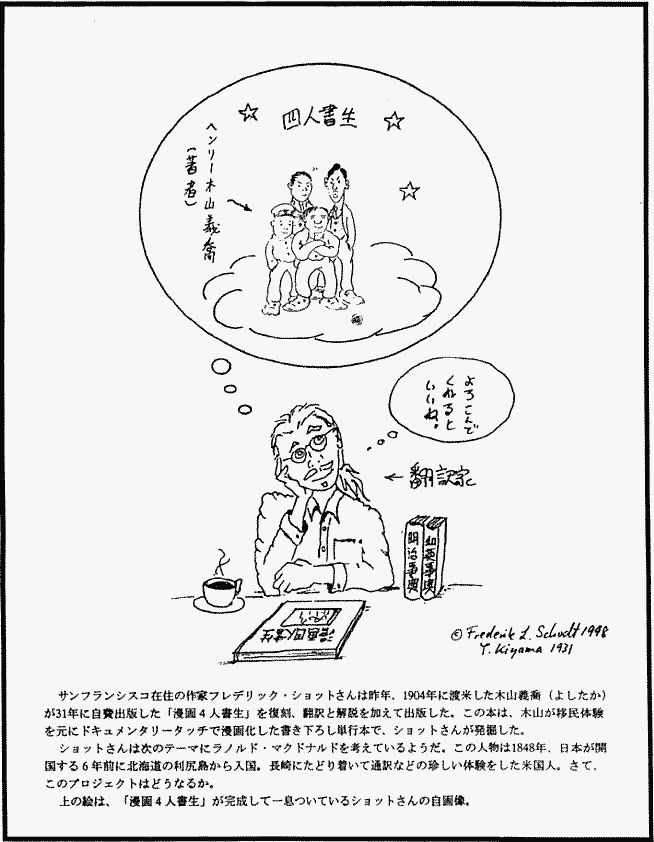
Henry Kiyama and The Four Immigrants Manga
A Japanese Experience in San Francisco, 1904-1924
『漫画四人書生』--木山義喬(著)--(by Henry Yoshitaka Kiyama).
Translated and annotated by Frederik L. Schodt.
Published by Stone Bridge Press.
STORY
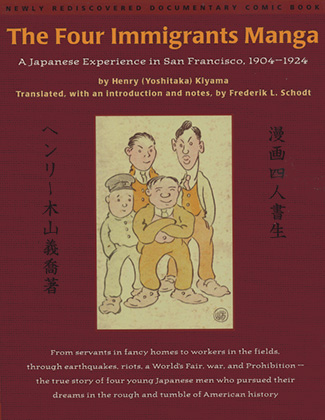
The Four Immigrants Manga English version cover
Henry Yoshitaka Kiyama was born on January 9, 1885, in Neu, a little village
in Tottori Prefecture, western Japan. In 1904, at the age of nineteen,
he sailed to San Francisco, where there was a growing community of Japanese
immigrants, many of whom were shosei, or young student-workers.
Kiyama was a talented artist, and while working at a variety of jobs he
attended the San Francisco Art Institute. He excelled at life-drawing and
painting, and between 1915 and 1920 won several awards and mentions. He
also won a scholarship from the New York Art Students League and exhibited
his work several times in San Francisco. An April 20, 1920, article in
the San Francisco Bulletin reported on an exhibit at the Palace
of Fine Arts, and described Kiyama's work as follows: "[His no. 115],
Old Wagon Shed, is a solidly modeled, well balanced and vigorously colored
design, and his 114, Old House at North Beach, in room 15, in soft green
and gray, is quietly effective."
Many of Kiyama's works survive today and are occasionally exhibited in the Yonago City Art Museum in Tottori Prefecture. He has a considerable reputation in the area of his birth, not as a cartoonist, but as an example of an early local artist who mastered Western art techniques.
Kiyama lived in San Francisco off and on until 1937, eventually opening his own art studio at 1901 Sutter Street, in nihonmachi, or "Japantown." It was a period of intense discrimination and agitation against Asian, and particularly Japanese, immigrants.
In 1937, Kiyama returned temporarily to his homeland. While he was there, war broke out between the United States and Japan. Unable to return to San Francisco, Kiyama taught art at a local high school in Neu, and continued painting. Henry Kiyama died on April 24, 1951, at the age of sixty-six. Cartooning was but a small part of his life, but the comic book he created in San Francisco may ultimately ensure his lasting fame.

The young Kiyama, probably around 1920, in front of a laundry on Gough St.(?), San Francisco. Note the parrot on his shoulder. This parrot appears on p. 132-3 of The Four Immigrants Manga and he later too>k it back to Japan with him.Unfortunately, it could not stand the cold winters of Kiyama's hometown, and passed away. Kiyama's descendants still have the original birdcage.
Between February 13 and 15, 1927, Henry Yoshitaka Kiyama held an exhibit of his work at the Kinmon Gakuen [Golden Gate Institute] in San Francisco. In addition to his drawings and paintings, he displayed what was titledManga Hokubei Iminshi, or "A Manga North American Immigrant History." A cartoon work consisting of 52 episodes, it depicted the lives of Kiyama and three friends in San Francisco between 1904 and around 1924.
Drawing in the style of newspaper comic strips then popular in America, Kiyama hoped to have his work serialized in a local news-paper. He was unable to do so. At 104 pages his work was too long, and probably too documentary in nature. Rather than a newspaper comic strip, Kiyama had really created the material for a "comic book."
In 1931, while visiting in Japan, Kiyama finally had his work printed. He brought it back with him to San Francisco, where he self-published it under the title of Manga Yonin Shosei, or "The Four Students Manga." It came with forewords and accolades by prominent local people, including the consul general of Japan. It is one of the first modern-format comic books ever published in the United States, especially with all-new material and a documentary, autobiographical theme.
Around 1980, I (Frederik L. Schodt) came across a copy of Kiyama's work in a library in Berkeley, California. In 1997 I began translating it, and in October 1998 it was published by Stone Bridge Press (Berkeley, California), retitled The Four Immigrants Manga: A Japanese Experience in San Francisco,1904-1924.
Kiyama's comic was handwritten in Meiji-period Japanese, but whenever other ethnic groups appear in the story they speak in their native language. Thus the European Americans speak English (somewhat fractured in Kiyama's rendition) and the Chinese denizens of San Francisco who occasionally appear speak Cantonese. In the Stone Bridge Press English edition, every effort has been made to preserve the flavor of Kiyama's unique multilingual style, and to remain faithful to his story. Kiyama's hand-lettered English text is left as-is, and for contrast his Japanese text has been rendered into typeset lowercase English using a turn-of-the-century font. Where Japanese puns are untranslatable, English equivalents have been substituted. In some places Kiyama's panels have been "flipped" to preserve the flow of English left-to-right logic. The Stone Bridge Press English edition of Kiyama's work comes with an introduction and extensive historical notes. It is in paperback, 7 x 9 inches in size, and 152 pages. It retails for $12.95, and has an ISBN no. of 1-880656-33-7. In 2000, the book was a finalist for the USA Pen/West translation award.
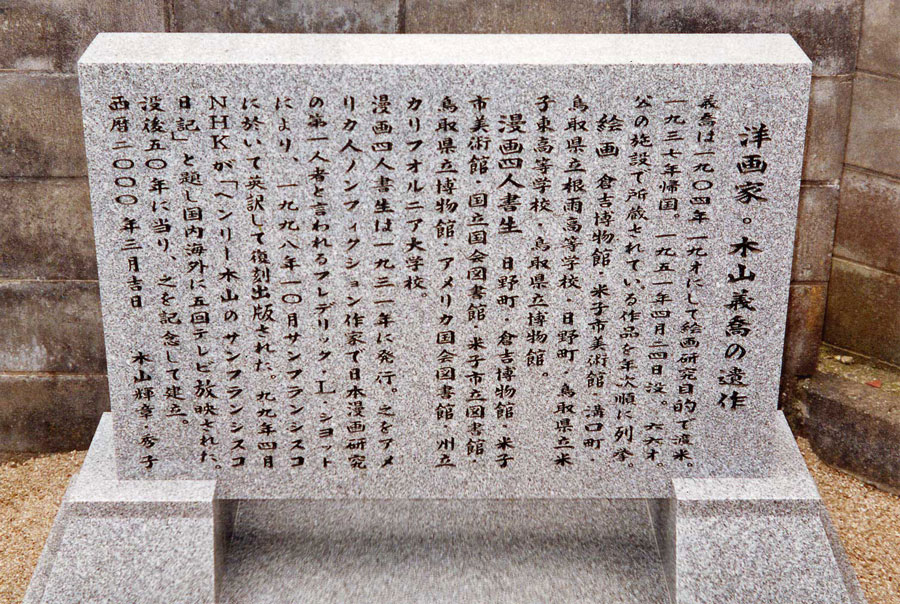
--Back to top--
A Few Reviews
- Roger Chapman, "A Comic Book Account of Japanese Immigrants in America," published on H-Net 1999.
- Andrew D. Arnold, "Coming to America", Time Magazine, February 19, 2005.
- Shaenon K. Garrity, Blog Entry for January 11, 2007.
- Michael Strickland, Blog Entry for "Civic Center", July 22, 2010.
Testimonials (1999) & Praise
- "A marvelous historical document and history, The Four Immigrants Manga offers astute commentaries on both the daily lives of workers and the momentous events that formed their contexts. This is a fascinating work — funny, pointed, moving — of extraordinary significance." — Gary Y. Okihiro, Professor of History and Director of the Asian American Studies Program, Cornell University.
- "Kiyama's The Four Immigrants Manga is a treasure. Like the Yellow Kid and Jiggs & Maggie, it is a splendid and authentic example of the immigrant literature of the period. More candid and outspoken than any of its contemporaries, it is a classic that demonstrates the true literary role of the comics to reflect ordinary life. Moreover, it is fun to read. It belongs in every library." — Will Eisner, graphic novelist, creator of The Spirit.
- "A fascinating journey back in time. Henry Kiyama's comic novel reminds us of the humor and humanity of our ancestors, as well as the hardships they faced. As a documentary filmmaker, I was thrilled by its honesty." — Steven Okazaki, Academy Award-winning filmmaker
- "Growing up in Seattle in the twenties I often heard my Issei father talk about his adventures and misadventures, amusing and tragic, as a young,naive and hopeful immigrant from Japan trying to make his way in the strange and often hostile land called America. Henry Kiyama's cartoons brought my father's stories back to life for me. Foryounger Japanese Americans who never had the privilege of hearing first-hand the recollections of immigrant forebears, the reincarnations of Kiyama's work will offer a bittersweet look into the history of their people. The cartoon medium is particularly effective for providing information without being pedantic." —Bill Hosokawa, former Editorial page Editor for the Denver Post, and regular contributor to the Pacific Citizen.
- "Frederik Schodt's discovery and translation is a major contribution to Asian American Studies, Japanese American history, California Studies and popular culture. The form is lively and upbeat. The use of humor to tell the story of the immigrants is a breakthrough and the use of visuals--be they called comics, cartoons or manga--is revolutionary way to tell this story. The preliminary comments as well as the afterwords and the footnotes are extremely valuable." — Isao Fujimoto, Professor, UC Davis
- "The Four Immigrants Manga is a story of hope ... Some of the [immigrants'] exploits are tragic, most are humorous but all share a masterful insight that all readers can relate to. This is an important— and highly enjoyable— book. Henry Kiyama is a wonderful storyteller." — Stan Sakai, author of Usagi Yojimbo.
- "Forty years before the birth of underground and alternative comix, Henry Kiyama was experimenting in comic strip form with comics as autobiography, comics as personal statement, comics as sociology, anthropology, and political science, not to mention comics as a comment on racial and class attitudes and antagonism. In a time when traditional comics didn't dare venture into this territory, Kiyama covers it as a matter of course, as if his strip is no more or less than his bemused comic diary. It is that, but it is more, much more." — Jules Feiffer, Pulitzer prize-winning cartoonist
More Info & News on Henry Kiyama and his Book:
-
Was the first American original comic book created
by a Japanese immigrant?
- The Four Immigrants Manga is increasingly used as a teaching tool in classrooms to introduce Asian American history. Stone Bridge Press therefore offers a free, downloadable TEACHING GUIDE for educators.
- [Soon to come: Backgrounds in The Four Immigrants Manga, then and now.
- The memorial in front of Neu Station, in Hino-cho, Tottori Prefecture.
- A cartoon, by me (in Japanese), about The Four Immigrants Manga
-
"Kiyama no Manga". An ODE to Kiyama; a series of read-along poems inspired by
The Four Immigrants Manga, by master wordsmith Bruce Berney of Astoria, Oregon. - A reprint of the original Japanese edition, with copious notes, including some by me, has been issued by Bunseishoin, and can be ordered from Bunseishoin in Tokyo. A more streamlined reprint is also available from Amazon Japan.
- Thanks to the hard work of Min Kahng (Book, Music & Lyrics), the Four Immigrants are now also a fabulous ★MUSICAL★!
- ★Four Immigrants goes GLOBAL! Now in ENGLISH! SPANISH! And in FRENCH!

English version of Four Immigrants Manga, 1998. 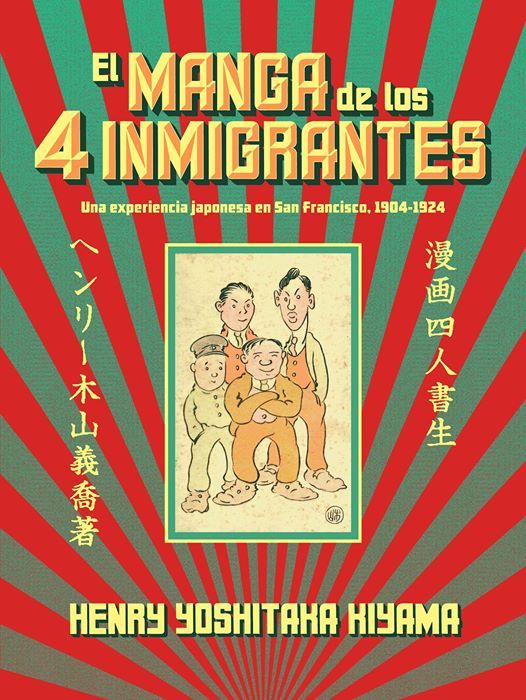
Spanish version of Four Immigrants Manga, 2015. 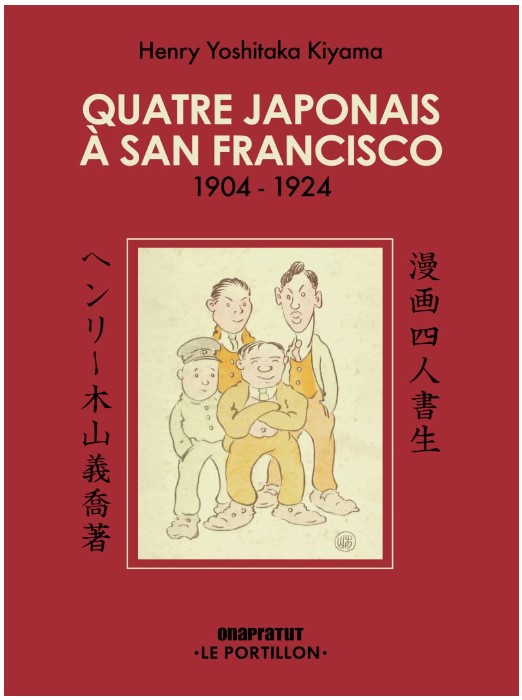
French version of Four Immigrants Manga 2023.
